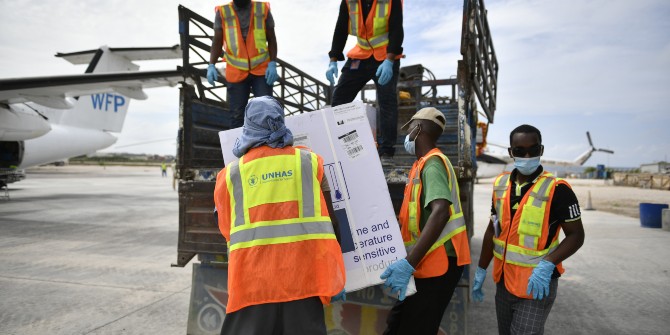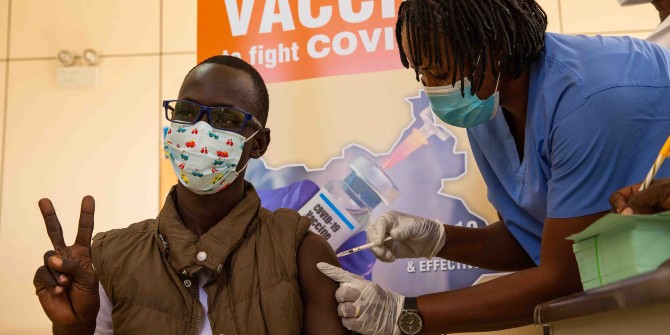Camille Terrier (University of Lausanne/LSE), Daniel L Chen (CNRS) and Matthias Sutter (Max Planck Institute) look at how COVID infections affected adolescents’ prosociality, an essential non-cognitive skill. The prosociality gap between students with high and low socio-economic status has doubled.
The pandemic is hitting poorer and less-educated families more severely than their richer and better-educated counterparts. This is particularly true for children and adolescents from low socio-economic status (SES) families, for whom the pandemic has meant worse mental health, lower educational attainment, lower academic aspirations, and larger dropout rates from school. In our new paper, we investigate the effect of the pandemic on another outcome that has received surprisingly little attention: prosociality.
Prosociality in adolescents is a key behavioural trait to consider and monitor for two reasons. First, because it affects children’s success in school and in life. Secondly, because it is quite heavily determined by students’ social background. Children from poorer and less-educated families tend to be significantly less altruistic, more selfish, and less cooperative and trusting. In our paper, we provide evidence for how COVID exposure, measured by an adolescent or a family member having the virus, reinforces inequalities in prosociality between high- and low-SES adolescents.
There are several reasons why COVID could potentially increase the prosociality gap between these groups. A first reason is medical: the chances of being hospitalised might differ for low-SES and high-SES families (due to differences in comorbidities or distance to hospitals, for instance), which may affect fear and ultimately ethical decision-making. Differences in unemployment or in parents’ ability to work from home could also explain a differential effect, through a potential impact on students’ stress and anxiety levels. On the other hand, some countervailing effects could also reduce the initial prosociality gap. Recent work has found less social distancing in low-SES families, which may help to preserve more social contacts and prosociality for low-SES students. For all these reasons, the overall effect of COVID infections is unclear and open to empirical investigation.
Novel experimental data on adolescents’ prosociality
We collected panel data on 363 high school students in France, who participated in two rounds of experiments. The first round was in October 2019. The second was during the first French lockdown in May 2020. Each round of experiment consisted of four different incentivised games to measure adolescents’ prosociality along four dimensions:
(i) the relative frequency of cooperation in a repeated prisoner’s dilemma game;
(ii) trust as the amount a first mover transfers to a second mover in a standard trust game;
(iii) altruism as the frequency with which subjects donate a fixed amount of money to a vaccination campaign (against measles), run by UNICEF, rather than taking a (successively) increasing amount of money for themselves; and
(iv) generosity as the share of each student’s total payoff from all tasks that he or she decides to donate to a non-governmental organisation (NGO).
We then transformed our four measures (cooperation, trust, altruism, and generosity) into a single principal component index of prosociality in order to get an encompassing measure of prosociality. We complement this data by collecting information on the effects of COVID on students and their families from a survey designed and administered online in May 2020. The French Ministry of Education provided administrative data on parents’ socio-economic status.

Establishing whether having the virus in one’s family has any effect on adolescents’ prosociality is difficult because of potential reverse causality, as prosociality might determine COVID exposure levels. We assuage this potential selection problem by using panel regression models to estimate the effect of an infection in the family. Our prosociality measures, available before the onset of COVID and during the first lockdown, allow us to examine changes in prosociality within adolescents over time (instead of using cross-sectional comparisons between adolescents). Our econometric approach therefore controls for differences in students’ characteristics that are fixed over time and might have endogenously determined COVID exposure. Our results show several striking facts.
Pre-pandemic, low-SES adolescents were less prosocial than high-SES students
In the four traits, low-SES students were, on average, less cooperative, less trusting, less altruistic, and less generous than high-SES students. Their overall level of prosociality was 0.27 standard deviations lower, which confirms previous findings.
The health and economic effects of the pandemic differed significantly between high and low-SES families
Families of high-SES students were more likely to experience a COVID infection (27.4 percent vs. 15.6 percent). They were also more often treated in hospital (8.9 percent vs. 1.6 percent). One explanation for these differences could be that high-SES families may have better access to both testing and healthcare in case of an infection. Parents of low-SES students also had a considerably higher likelihood of having a job where they are regularly in contact with others and thus potentially with COVID (0.77 vs. 0.49 parents per family on average), and they were significantly more likely to have lost their job or be on a partial unemployment scheme than parents of high-SES students (0.475 vs. 0.307 parents per family on average). Finally, low-SES families were less likely to work from home during lockdown.
Infections within families amplified the initial prosociality gap between high- and low-SES students
A COVID infection within an adolescent’s family reduced the prosociality of low-SES adolescents by 0.61 to 0.94 of a standard deviation more than for high-SES students. These are very strong effects, considering the pre-COVID difference of 0.27 standard deviations between high- and low-SES adolescents. This means that infections within families amplify the difference in prosociality between high- and low-SES students, by increasing the gap by a factor of two to three in case of an infection. As illustrated in Figure 1, this effect is strikingly stable when we account for the effects of parental job loss, contact job, home office, and hospitalisations. In fact, none of these control variables themselves have a differential effect on high- and low-SES adolescents’ prosociality.
Figure 1: Effect of COVID infections on prosociality of adolescents from low-SES families (relative to high-SES adolescents)

Notes: This figure shows the estimated coefficient of the interaction term COVID-19 x Low-SES background on adolescents’ prosociality index. The whiskers denote the 95 percent confidence interval.
Overall, our study suggests that COVID exposure within a family widens the prosociality gap between low- and high-SES students. Considering the importance of non-cognitive skills in general and of prosociality in particular, if these negative effects persist, the long-term consequences for these adolescents may be severe.
This post represents the views of the authors and not those of the COVID-19 blog, nor LSE. It is based on Terrier, C., Chen, D., Sutter, M. (2021) COVID-19 within families amplifies the prosociality gap between adolescents of high and low socioeconomic status, Proceedings of the National Academy of Science Nov 2021, 118 (46).





